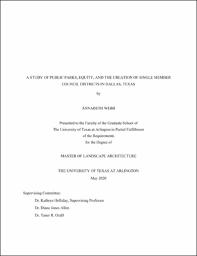
ATTENTION: The works hosted here are being migrated to a new repository that will consolidate resources, improve discoverability, and better show UTA's research impact on the global community. We will update authors as the migration progresses. Please see MavMatrix for more information.
Show simple item record
| dc.contributor.advisor | Holliday, Kathryn E. | |
| dc.creator | Webb, Annabeth | |
| dc.date.accessioned | 2020-06-15T14:41:17Z | |
| dc.date.available | 2020-06-15T14:41:17Z | |
| dc.date.created | 2020-05 | |
| dc.date.issued | 2020-06-04 | |
| dc.date.submitted | May 2020 | |
| dc.identifier.uri | http://hdl.handle.net/10106/29146 | |
| dc.description.abstract | This research explores the civic governance and political structure of the city council election systems in Dallas, Texas after the Voting Rights Act in order to discover the change in minority representation and its impact on the equity and distribution of public parks within the city of Dallas. This thesis explores this particular political mechanism for equity creation in the City of Dallas during two time periods: at the drastic change to 14 single-member districts in 1991, and the changes made beyond the 1994 Dallas Plan. Within the Dallas planning history, there is little literature on equity and history of racially segregated spaces. There is also little record of the dynamics of the involvement of civic governance after the civic structure changed from an at-large city council to a single-member district council. This research is focused on designed parks within the city of Dallas, their distribution in the council districts, and whether minority and non-minority representation translates to park distribution.
This research uses qualitative and quantitative techniques (Sommer, 2002) in the forms of archival and secondary data obtained from Dallas Municipal Archives, online exhibits, and secondary studies that are used to inform a series of detailed map comparisons in order to analyze and determine the impact of single-member council districts on equity, distribution, and development of public parks in the city of Dallas. This analysis shows that single-member districts did not have an immediate effect on equity creation in parks by showing evidence of less new park placement in consistently minority represented council districts versus consistent white represented council districts through comparative maps and counting of parks from 1991 to 2017. Instead it appears that later efforts after the release of Trust for Public Land’s study on Smart Growth for Dallas had a greater impact than the single-member district verdict on the equity of public parks in Dallas.
It is important to continue conducting conversations on the relationship between equity and Landscape Architecture; as the profession follows the example of its professional organization, whose values are integrity and diversity, but does not fully reflect the shifting demographics of the nation. | |
| dc.format.mimetype | application/pdf | |
| dc.language.iso | en_US | |
| dc.subject | Dallas parks | |
| dc.subject | Equity | |
| dc.subject | Council districts | |
| dc.title | A Study of Public Parks, Equity, and the Creation of Single Member Council Districts in Dallas, Texas | |
| dc.type | Thesis | |
| dc.degree.department | Landscape Architecture | |
| dc.degree.name | Master of Landscape Architecture | |
| dc.date.updated | 2020-06-15T14:41:17Z | |
| thesis.degree.department | Landscape Architecture | |
| thesis.degree.grantor | The University of Texas at Arlington | |
| thesis.degree.level | Masters | |
| thesis.degree.name | Master of Landscape Architecture | |
| dc.type.material | text | |
| dc.creator.orcid | 0000-0002-3954-2304 | |
Files in this item
- Name:
- WEBB-THESIS-2020.pdf
- Size:
- 17.08Mb
- Format:
- PDF
This item appears in the following Collection(s)
Show simple item record


